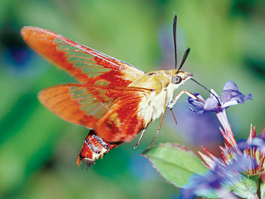home | metro silicon valley index | the arts | visual arts | review

Photograph by Carll Goodpasture
THE COLLECTOR: A hummingbird moth gathers some pollen.
All the Buzz
A new show at the Rosicrucian Museum proves that when the bees and other pollinators go, we go
By Gary Singh
WITH ALL the hysteria surrounding killer bees in previous decades, one never considers that instead of coming to attack America, bees might actually be disappearing from the globe instead. According to the traveling exhibit "Vanishing Pollinators: Photography by Carll Goodpasture," currently at the Rosicrucian Museum, the disappearance of bees and other pollinators hasn't reached the crisis level yet, but it's getting close. The awareness factor should be cranked up a few notches as pollinator populations are in consistent decline throughout the world.
A Smithsonian Institution traveling show, Vanishing Pollinators features 34 vivid up-close-and-personal photos of insects in action with certain flowers. Goodpasture himself is a biologist who has been photographing nature for decades, and these photos function both as art and as scientific commentary on man's interaction with nature.
Placards line the walls and provide explanatory remarks on a mishmash of information: how electromagnetic radiation from cell phones contributes to the disappearance of bees; how plants and pollinators evolved together throughout time; how massive losses of feral honeybees contribute to the significant loses in colonies maintained by beekeepers.
Also, since bees are the ones who pollinate large supplies of alfalfa, clover and hay, millions of sheep, cattle and goats depend on them. The entire food chain is at risk if bees and other insect pollinators continue to rapidly decline.
What's more, the exhibit takes place in the museum's Lecture Gallery. Pulled-back curtains decorated with mantralike images grace the entryway, and a large obelisk flanked by potted plants greets you upon entrance. You realize immediately that you're in the Rosicrucian Museum, and there's even a display case exploring the history of beekeeping, including ancient Egypt. This sits right next to a few interactive computer exhibits explaining how pollination works. And on the far wall, you see a movie that ties the whole thing together.
The photos themselves are drop-dead gorgeous in a number of ways. Averaging about 11 by 17 inches, each photo provides an in-depth look-see into a variety of insects and a variety of flowering plants. If you've never seen the surface of a hummingbird moth's eyeball or a bright orange butterfly descending on a wild passionflower, look no further.
In fact, if you're an insomniac and have nervous system issues and your supply of passionflower capsules has gone dry, maybe staring at that last image will remind you to fill it up again.
The colors radiate outward from the photos, and I wouldn't be surprised if the Rosicrucians deliberately laid them out according to some ancient hermetic color-theory principles. In any event, these photos will either make a flower enthusiast out of you or rekindle a previous interest in flowers, if you had one, that is.
But there's more than just stunning, dramatic, up-close shots of the interrelationships between plants and insects. There's even a box where you can lift up wooden lids and smell aromas of rose, lavender, jasmine, lilac, rosemary and vanilla—almost like being in an occult shop, sampling potential powders for an upcoming ritual.
And since bees, bats, moths, butterflies, hummingbirds and other pollinators play such an important role in producing a predominance of the foods we consume, a display case even shows many of them, although it looks like a cheesy cover a 1950s issue of Good Housekeeping: a red-and-white checkerboard tablecloth sits underneath a variety of substances that would not exist if not for pollinators: almonds, blueberries, chocolate bars, coffee beans, raisins, candles, peanut butter and more. Basically, pollinators are responsible for probably one-third of all the food most people put into their mouths.
What can you do to help? There are several things. One of the placards points out a few ways: Grow your own bee garden or create a pollinator-friendly landscape. Buy local antibiotic-free honey. Stuff like that, the signs say. We need bees, folks.
VANISHING POLLINATORS shows at the Rosicrucian Egyptian Museum, 1342 Naglee Ave., San Jose. (408.947.3636)
Send a letter to the editor about this story.
|
|
|
|
|
|